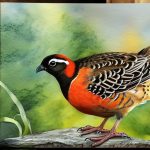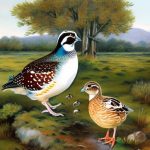Jumbo Brown Quail, also known as Coturnix coturnix, are a popular breed of quail that are raised for their meat and eggs. They are known for their large size, rapid growth, and high egg production, making them a valuable addition to any poultry farm. Jumbo Brown Quail are a hardy and adaptable breed, making them relatively easy to care for and raise. They are also known for their calm and docile temperament, making them a great choice for beginners or those looking to add a new type of poultry to their farm.
Jumbo Brown Quail are native to Europe and Asia, but have been widely domesticated and are now raised all over the world. They are a popular choice for small-scale poultry farmers due to their small size and low maintenance requirements. Jumbo Brown Quail are also known for their ability to thrive in a variety of environments, making them a versatile option for farmers in different climates and regions. Whether you are looking to raise quail for meat or eggs, Jumbo Brown Quail are a great choice for anyone looking to add a new type of poultry to their farm.
Table of Contents
- 1 Selecting Breeding Stock
- 2 Breeding Environment and Housing
- 3 Nutrition and Feeding
- 4 Breeding and Incubation
- 5 Caring for Chicks
- 6 Health and Disease Management
- 7 FAQs
- 7.1 What is a jumbo brown quail?
- 7.2 How do you breed jumbo brown quail?
- 7.3 What do jumbo brown quail eat?
- 7.4 What are the ideal conditions for breeding jumbo brown quail?
- 7.5 How long does it take for jumbo brown quail to reach maturity?
- 7.6 What are some common health issues in jumbo brown quail?
Key Takeaways
- Jumbo Brown Quail are a popular breed for their large size and high egg production.
- When selecting breeding stock, look for healthy birds with good body conformation and strong egg-laying ability.
- Provide a breeding environment with plenty of space, nesting boxes, and protection from predators.
- A balanced diet with high-quality feed and access to clean water is essential for breeding quail.
- Proper incubation and care for chicks, including warmth, protection, and proper nutrition, are crucial for successful breeding.
Selecting Breeding Stock
When it comes to selecting breeding stock for Jumbo Brown Quail, there are a few key factors to consider. First and foremost, it is important to choose birds that are healthy and free from any genetic defects or diseases. Look for birds that are active, alert, and have bright eyes and clean feathers. It is also important to select birds that are of good size and weight, as this will ensure that they are able to produce healthy offspring.
Another important factor to consider when selecting breeding stock is the birds’ egg production and fertility. Look for birds that have a history of good egg production and fertility, as this will ensure that your breeding program is successful. It is also important to consider the birds’ temperament, as you want to select birds that are calm and docile, as this will make handling and caring for them much easier. By carefully selecting breeding stock that meets these criteria, you can ensure that your Jumbo Brown Quail breeding program is off to a strong start.
Breeding Environment and Housing
Creating the right breeding environment and housing for Jumbo Brown Quail is essential for their health and productivity. When it comes to housing, it is important to provide enough space for the quail to move around comfortably. A good rule of thumb is to provide at least 1 square foot of space per bird. The housing should also be well-ventilated and provide protection from predators and the elements. Additionally, it is important to provide nesting boxes for the quail to lay their eggs in.
The breeding environment should also include proper lighting to stimulate egg production. It is important to provide 14-16 hours of light per day to encourage the quail to lay eggs consistently. This can be achieved using artificial lighting in the quail housing. It is also important to provide a balanced diet for the quail, as this will ensure that they are healthy and productive. By creating the right breeding environment and housing for your Jumbo Brown Quail, you can ensure that they are comfortable, healthy, and productive.
Nutrition and Feeding
Proper nutrition and feeding are essential for the health and productivity of Jumbo Brown Quail. A balanced diet is crucial for ensuring that the quail are healthy and able to produce high-quality eggs and meat. A good quail feed should contain a mix of grains, seeds, and protein sources such as soybean meal or fish meal. It is also important to provide access to grit, which helps the quail digest their food properly.
In addition to a balanced feed, it is important to provide access to clean water at all times. Quail can drink a surprising amount of water, especially when they are laying eggs, so it is important to ensure that they always have access to fresh water. It is also important to monitor the quail’s feed intake and adjust their diet as needed based on their age and production level. By providing a balanced diet and access to clean water, you can ensure that your Jumbo Brown Quail are healthy and productive.
Breeding and Incubation
Breeding and incubating Jumbo Brown Quail requires careful planning and attention to detail. When it comes to breeding, it is important to provide the right ratio of males to females in order to ensure successful mating. A good rule of thumb is to provide one male for every four females. This will help prevent over-mating and ensure that the eggs are fertilized properly.
Once the eggs have been laid, they can be collected and placed in an incubator for hatching. The incubation period for Jumbo Brown Quail eggs is approximately 17 days. During this time, it is important to monitor the temperature and humidity levels in the incubator to ensure that the eggs develop properly. It is also important to handle the eggs carefully during the incubation process in order to prevent any damage that could affect the chicks’ development.
Caring for Chicks

Caring for Jumbo Brown Quail chicks requires attention to detail and careful management. Once the chicks have hatched, it is important to provide them with a warm and dry environment in order to help them thrive. A brooder with a heat lamp or heat pad can help provide the chicks with the warmth they need during their first few weeks of life. It is also important to provide access to clean water and a balanced chick feed in order to ensure that they are healthy and growing properly.
As the chicks grow, it is important to monitor their development and adjust their care as needed. This may include providing additional space as they grow, adjusting their diet as they mature, and monitoring their health closely. By providing attentive care and management, you can ensure that your Jumbo Brown Quail chicks grow into healthy and productive adults.
Health and Disease Management
Maintaining the health of your Jumbo Brown Quail is essential for their productivity and well-being. It is important to monitor the quail closely for any signs of illness or disease, such as lethargy, loss of appetite, or changes in behavior. If you notice any signs of illness, it is important to isolate the affected birds and seek veterinary care as soon as possible.
In addition to monitoring for signs of illness, it is important to practice good biosecurity measures in order to prevent the spread of disease within your quail flock. This may include regularly cleaning and disinfecting the quail housing, limiting visitors to the quail area, and practicing good hygiene when handling the birds. By practicing good biosecurity measures and monitoring the quail closely for signs of illness, you can help prevent disease outbreaks and ensure that your Jumbo Brown Quail remain healthy and productive.
If you’re interested in breeding jumbo brown quail, you may also want to consider the housing and coop options for your birds. Poultry Wizard offers insightful articles on creating the perfect environment for your quail, such as “Turning a Shed into a Chicken Coop,” “A-Frame Chicken Coop,” and “Chicken Coop 10.” These resources can provide valuable tips and ideas for designing a suitable living space for your quail to thrive. Check out their article on Turning a Shed into a Chicken Coop for practical advice on converting existing structures into comfortable homes for your birds.
FAQs
What is a jumbo brown quail?
Jumbo brown quail, also known as Coturnix coturnix, are a species of quail that are popular for their large size and delicious meat. They are commonly bred for their meat and eggs.
How do you breed jumbo brown quail?
Breeding jumbo brown quail involves providing them with a suitable environment, proper nutrition, and ensuring that they have the right conditions for mating and egg-laying. This may include providing nesting boxes, a balanced diet, and a suitable breeding ratio of males to females.
What do jumbo brown quail eat?
Jumbo brown quail are omnivores and their diet consists of a variety of foods including seeds, grains, insects, and green vegetation. It is important to provide them with a balanced diet to ensure their health and productivity.
What are the ideal conditions for breeding jumbo brown quail?
Jumbo brown quail thrive in a well-ventilated and spacious environment with access to clean water, suitable nesting areas, and a balanced diet. They also require the right lighting conditions and a suitable temperature range for breeding and egg-laying.
How long does it take for jumbo brown quail to reach maturity?
Jumbo brown quail typically reach maturity at around 6-8 weeks of age. At this point, they are ready for breeding and can start laying eggs.
What are some common health issues in jumbo brown quail?
Common health issues in jumbo brown quail include respiratory infections, parasites, and nutritional deficiencies. It is important to monitor their health and provide proper care to prevent and address any health issues that may arise.
Meet Walter, the feathered-friend fanatic of Florida! Nestled in the sunshine state, Walter struts through life with his feathered companions, clucking his way to happiness. With a coop that’s fancier than a five-star hotel, he’s the Don Juan of the chicken world. When he’s not teaching his hens to do the cha-cha, you’ll find him in a heated debate with his prized rooster, Sir Clucks-a-Lot. Walter’s poultry passion is no yolk; he’s the sunny-side-up guy you never knew you needed in your flock of friends!







